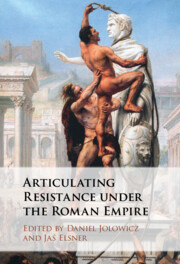Book contents
- Articulating Resistance under the Roman Empire
- Articulating Resistance under the Roman Empire
- Copyright page
- Contents
- Contributors
- Acknowledgements
- Abbreviations
- Introduction Articulating Resistance
- Part I Language and Identity
- Part II Genres of Literary Resistance
- Part III Identity Negotiation
- Part IV Religion and Resistance
- Chapter 8 Anti-Roman Sibyl(s)
- Chapter 9 Traditions of Resistance in Greco-Egyptian Narratives
- Chapter 10 Julian the Emperor and the Reaction against Christianity
- Epilogue Resisting Resistance
- References
- Index
Chapter 8 - Anti-Roman Sibyl(s)
from Part IV - Religion and Resistance
Published online by Cambridge University Press: 23 December 2022
- Articulating Resistance under the Roman Empire
- Articulating Resistance under the Roman Empire
- Copyright page
- Contents
- Contributors
- Acknowledgements
- Abbreviations
- Introduction Articulating Resistance
- Part I Language and Identity
- Part II Genres of Literary Resistance
- Part III Identity Negotiation
- Part IV Religion and Resistance
- Chapter 8 Anti-Roman Sibyl(s)
- Chapter 9 Traditions of Resistance in Greco-Egyptian Narratives
- Chapter 10 Julian the Emperor and the Reaction against Christianity
- Epilogue Resisting Resistance
- References
- Index
Summary
The Sibylline Oracles, Greek hexameters blending history, eschatological prophecy, and moral advice for various nations, are ascribed to the pagan prophetess Sibyl but were in fact composed and updated by Jews and then Christians from the second century BCE onwards. Many oracles feature an explicitly anti-Roman tone. Considering modern labels for the collection, from ‘missionary’ to ‘apocalyptic’ literature, this chapter evaluates a range of reasons to consider the growth of the corpus as an example of resistance to Roman rule, bearing in mind how (subtly) ‘resistance literature’ is usually said to operate. First, both the ascription of the oracles to the Sibyl, so appropriating what had become a Roman tool of power and knowledge, and the use of archaic Greek hexameters may be considered forms of ‘compositional resistance’ whereby authoritative genres are inverted. The Sibyllists’ wish to control forms of language and knowledge dominant in their society may also be deduced through close analysis of their language and styles. Our examination then moves to the level of content or theme (‘contextual resistance’), subdivided into the characteristically Sibylline topics of schematised history, eschatological anticipation about Nero, and forms of recommended behaviour. It is shown that biblical and Roman models are invoked and turned against Rome.
Keywords
- Type
- Chapter
- Information
- Articulating Resistance under the Roman Empire , pp. 185 - 203Publisher: Cambridge University PressPrint publication year: 2023

